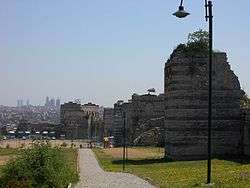Palace of the Porphyrogenitus

The Palace of the Porphyrogenitus (Greek: το παλάτι τοῦ Πορφυρογεννήτου), known in Turkish as the Tekfur Sarayı ("Palace of the Sovereign"),[1] is a late 13th-century Byzantine palace in the north-western part of the old city of Constantinople (present-day Istanbul, Turkey). An annex of the greater palace complex of Blachernae, it is the best preserved of the three Byzantine palaces to survive in the city (together with the ruins of the Boukoleon Palace; and the ruins of the Great Palace of Constantinople with its surviving substructures, retrieved mosaics and standing Magnaura section), and one of the few relatively intact examples of late Byzantine secular architecture in the world.
History
The Palace was constructed during the late 13th or early 14th centuries as part of the Blachernae palace complex, where the Theodosian Walls join with the later walls of the suburb of Blachernae. Although the palace appears at first glance to be named after the 10th-century emperor Constantine VII Porphyrogenitus, it was built long after his time, and is in fact named after Constantine Palaiologos, a son of the Emperor Michael VIII Palaiologos.[2] "Porphyrogenitus", meaning literally "born to the purple", indicated a child born to a reigning emperor. The palace served as an imperial residence during the final years of the Byzantine Empire.
The palace suffered extensive damage due to its proximity to the outer walls during the Ottoman conquest of Constantinople in 1453. Afterwards it was used for a wide variety of purposes. During the 16th and 17th century, it housed part of the Sultan's menagerie. The animals were moved elsewhere by the end of the 17th century, and the building was used as a brothel. From 1719, the Tekfur Sarayı pottery workshop was established, and began to produce ceramic tiles in a style similar to that of İznik tiles, but influenced by European designs and colors. The workshop had five kilns and also produced vessels and dishes.[3] It lasted for around a century before going out of business, and by the first half of the 19th century, the building became a poorhouse for Istanbul Jews. In the early 20th century, it was briefly used as a bottle factory, before being abandoned.[4] As a result, only the elaborate brick and stone outer façade survives today, as one of the few surviving examples of secular Byzantine architecture. As of July 2010, the palace has been undergoing extensive restoration, and remains closed to the public. As of March 2015, the building now has roof and glass windows.
Architecture
The Palace was a large three-story building located between the inner and outer fortifications of the northern corner of the Theodosian Walls. The ground floor is an arcade with four arches, which opens into a courtyard overlooked by five large windows on the first floor. The top floor of the structure project above the walls, and has windows on all four sides. On the east is the remnant of a balcony. The roof and all of the floors of the structure have disappeared. The remaining walls are elaborately decorated in geometric designs using red brick and white marble typical of the late Byzantine period.
Gallery
 Walls seen from the inner courtyard
Walls seen from the inner courtyard- Remains of the chapel (southern wall)
 Details of marble decoration (southern wall)
Details of marble decoration (southern wall) The Palace of the Porphyrogenitus, seen in the background, with the Theodosian Walls in front
The Palace of the Porphyrogenitus, seen in the background, with the Theodosian Walls in front
See also
References
Sources
- Freely, John (2000). Blue Guide Istanbul. W. W. Norton & Company. ISBN 0-393-32014-6.
- Cruikshank, Dan (1996). Sir Banister Fletcher's A History of Architecture. Architectural Press. ISBN 0-7506-2267-9.
- Blair, Shelia (1996). The Art and Architecture of Islam, 1250-1800. Yale University Press. ISBN 0-300-06465-9.
- Treadgold, Warren (1997). A History of the Byzantine State and Society. Stanford University Press. ISBN 0-8047-2630-2.
- Van Millingen, Alexander (1899). Byzantine Constantinople: The Walls of the City and Adjoining Historical Sites. London: John Murray Ed.
External links
| Wikimedia Commons has media related to Palace of the Porphyrogenitus. |
- 3D reconstruction of the palace from the Byzantium 1200 website
- Tekfur Saray Byzantine Palace of the Porphyrogenitus
- Pictures of the situation in 2015
Coordinates: 41°02′02″N 28°56′25″E / 41.03389°N 28.94028°E